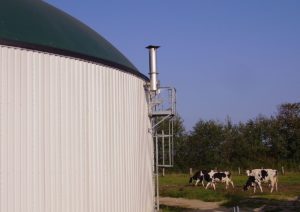Massachusetts farmers turn food waste into electricity
In an effort to reduce food waste, the Massachusetts Department of Environmental Protection prohibited the disposal of organic wastes by institutions or businesses that create more than one ton of it per week in October 2014. This means that businesses such as grocery stores are left unable to simply throw out the food waste they produce, but find other uses for it. Fortunately, local dairy farmers have come up with an innovative solution to this problem: using food waste to generate electricity.
Often disregarded, food waste presents a substantial threat to global environmental resilience. Global food waste is the third largest source of greenhouse gas emissions, following only the emissions of China and the United States from all origins. When food waste begins to erode in landfills, methane is released, which quickly absorbs heat and causes the temperature to rise. In the United States alone, 133 billion pounds of food were wasted in 2018. Overall, nearly 40% of US food production each year goes to waste.

Gathering unused food along with manure from their cows, these farms use anaerobic digestion to turn methane emissions from the waste into a source of renewable energy. At local grocery stores such as Whole Foods and other retailers, unsold and scrapped food is turned into a slurry by an industrial-strength grinder at each location. From there, the liquid is shipped to dairy farms to be broken down along with the manure micro-organisms and without oxygen. The byproducts of the process include methane and other greenhouse gases, which can be burned as biogas to generate one megawatt of electricity each day per farm, most of which gets returned to the grid.
Turning food waste into biogas presents a resilient solution to Massachusetts’ food waste problem. As there is a continuous production of waste, this biogas can serve as a steady source of energy for the state. Additionally, the process not only helps businesses cut their greenhouse gas emissions, but removes phosphorus and metals from waste, preventing toxic substances from entering water supplies. Furthermore, it offers another source of income for dairy farmers; dairy farms have had a record number of closures in the past few years, so this solution keeps many families and businesses afloat that would not have had the opportunity otherwise. However, there are some reservations about the feasibility of anaerobic digestion. The process is not feasible for smaller farms – it is recommended that operating businesses have at least 300 cows, leaving smaller family farms in the lurch. Moreover, a high land use is required to store the digesters themselves and the byproducts, prompting the possibility of deforestation. Finally, anaerobic digestion does not change the culture of waste among consumers, but rather capitalizes on it. Despite its pitfalls, utilizing local food waste to create energy strengthens Massachusetts’ resilience and helps to cut its greenhouse gas emissions.
Sources and Additional Reading
Mass.gov – Commercial Food Material Disposal Ban
NPR – Chew On This: Farmers Are Using Food Waste To Make Electricity
Mass.gov – Biogas Addresses Massachusetts Corner of Global Food Waste Problem
Mic – Turning food waste into electricity could make grocery stores and farms more sustainable
Green Coast – Facts About Anaerobic Digesters: What are the Pros and Cons?
Loughborough University – The Advantages and Disadvantages of Anaerobic Digestion as a Renewable Energy Source
Civic Eats – What’s Behind the Crippling Dairy Crisis? Family Farmers Speak Out
The Atlantic – Why Americans Lead the World in Food Waste
